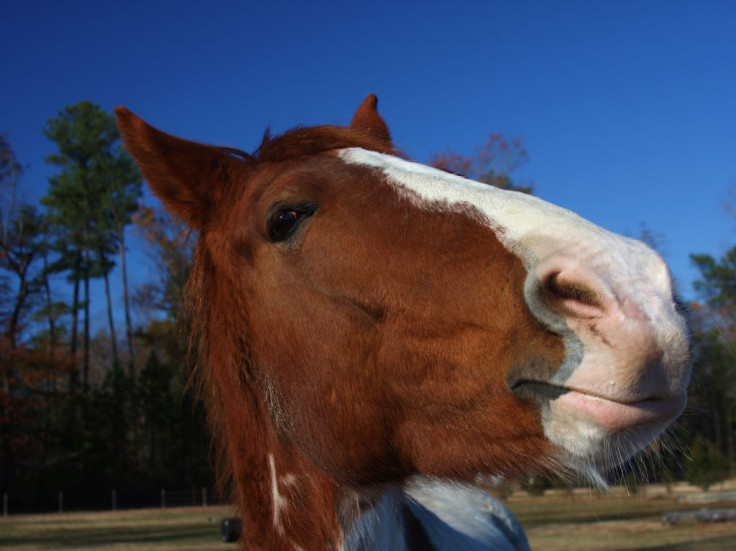Facial Expressions Are The Same In Humans And Horses, May Influence Social Cognition

There’s a preexisting notion that the more distance between an animal and a human on the evolutionary chain, the more their facial expressions differ. However, new research published in PLOS One finds humans and horses may actually have the same face.
Like humans, researchers reported, horses use the muscles underlying their facial features, including their nostrils, lips, and eyes, during various social situations. So, to build on previous studies, the researchers designed an equine version of the existing Facial Action Coding System (EquiFACS) in order to objectively identify all the facial expressions horses produce. Since the original system was developed for humans, researchers would be able to compare the codes for any similarities.
The process of understanding horses’ facial expressions was two-fold: one, researchers used “an innovative ‘face mask’ method, where the facial musculature [from a single horse’s head] is removed from the deep muscles and the skull of the skin, creating a ‘facial mask’ that holds all of the facial muscles.” The anatomical investigation allowed them to examine the muscles and their attachments to the bone, skin, and cartilage, as well as provide a three-dimensional comparison to one another as well as to the horse’s skull. Then, researchers analyzed existing video footage of 86 horses’, measuring for certain behaviors, including how they interacted with humans.
Though facial structures among horses and humans are different, researchers were able to identify similar expressions. For example, in some situations, “horses will display more of the white sclera due to a change in the opening of the eye or position of the eyeball.” The amount of sclera is associated with fear, and like humans, horses’ widen their eyes when they’re scared.
“Horses also have a zygomatic major muscle (generally termed the zygomaticus muscle) that pulls the lip corners back,” the researchers added. “However, this action has a slightly different appearance in horses due to their different facial morphology.” Still, horses’ can pull their lips back in a curl, exposing their teeth and gums.
Jennifer Wathan, an author of the study and doctoral researcher at the University of Sussex in London, explained that despite being predominantly visual animals, horses’ facial expressions have “been largely overlooked.” Wathan was genuinely surprised to find “the rich repertoire of complex facial movements in horses, and how many of them are similar to humans.”
These findings, Wathan said, “contribute to a growing body of evidence suggesting that social factors have had a significant influence on the evolution of facial expression.” Their coding system allows them to document facial movements in different social and emotional contexts, which will eventually help them better understand how horses socialize. More interesting than that is the potential of these findings to improve the current understanding of the social condition and comparative psychology.
One study from Valdosta State University cited that social cognition attempts “to understand and explain how the thoughts, feelings, and behavior of individuals are influenced by the actual, imagined, or implied presence of others.” If we’re strictly talking animals, separate research shows the process of domestication enables, say, dogs to communicate with humans in unique ways — they essentially develop social-cognitive abilities.
“Consequently, horses show fission-fusion dynamics; a variation of the same complex social organization that is seen in humans, bonobos, chimpanzees, and macaques, as well as elephants, spotted hyenas, and many cetaceans,” the researchers concluded. “Group life in these societies is determined by complex, long-term social relationships that must be maintained, suggesting effective communication would be adaptive.”
Source: Wathan J, Burrows A, Waller BM, and McComb K. EquiFACS: The equine Facial Actin Coding System. PLOS One. 2015.



























